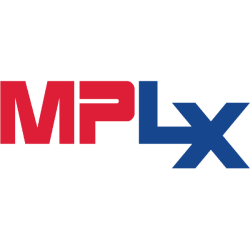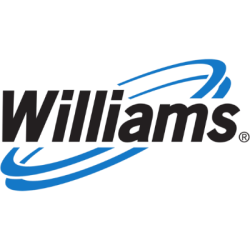EPD

Enterprise Products Partners L.P.
EPD
(2.8)32,15 USD
8.94% ROA
27.75% ROE
11.02x PER
63.329.354.000,00 USD
108.91% DER
7.04% Yield
10.35% NPM
Enterprise Products Partners L.P. Stock Analysis
Enterprise Products Partners L.P. Fundamental Analysis
Fundamental analysis in stock investing is like studying the foundation of a house before buying it. It involves looking at a company's financial health, like its earnings, assets, and debts, to determine if it's a good investment based on its fundamental strength and potential for growth.
| # | Analysis | Rating |
|---|---|---|
| 1 |
ROE
ROE surpassing expectations (20.18%) highlights strong profitability and efficient use of shareholders' equity, making it an appealing investment prospect. |
|
| 2 |
Assets Growth
With continuous growth in revenue over the last five years, this company has proven to be a lucrative investment option, showcasing its strong financial performance. |
|
| 3 |
Dividend Growth
With a history of consistent dividend increases over the last five years, the company has proven to be a reliable choice for investors seeking steady income. |
|
| 4 |
Dividend
Investors can trust the company's impressive dividend track record, consistently distributing dividends over the past five years, showcasing a strong commitment to rewarding shareholders. |
|
| 5 |
ROA
The stock's ROA (9.24%) shows that it's doing a pretty good job at making money from its assets, making it a solid choice to invest and earn steady profits. |
|
| 6 |
PBV
The stock's PBV ratio (2.12x) indicates a justifiable valuation, presenting a compelling choice for investors seeking reasonable returns. |
|
| 7 |
Buffet Intrinsic Value
The company's stock seems undervalued (250) by Warren Buffett's formula, indicating a promising investment opportunity as its intrinsic value exceeds the market price. |
|
| 8 |
DER
The company has a high debt to equity ratio (106%), which means it owes a lot of money compared to what it actually owns, making it financially risky. |
|
| 9 |
Revenue Growth
Company's revenue has stayed stagnant, showing no signs of improvement and making it a less favorable choice. |
|
| 10 |
Net Profit Growth
This company's net profit has remained flat over the past five years, suggesting a lack of growth and making it a less attractive investment opportunity. |
|
| 11 |
Graham Number
The Graham number analysis indicates that this company's stock price is likely overpriced, raising concerns about its investment potential. |
Enterprise Products Partners L.P. Technical Analysis
Technical analysis in stock investing is like reading the patterns on a weather map to predict future weather conditions. It involves studying past stock price movements and trading volumes to make predictions about where a stock's price might go next, without necessarily looking at the company's financial health.
| # | Analysis | Recommendation |
|---|---|---|
| 1 | Awesome Oscillator | Sell |
| 2 | MACD | Buy |
| 3 | RSI | Hold |
| 4 | Stoch RSI | Sell |
Enterprise Products Partners L.P. Price Chart
Financial Statements
Financial statements are like report cards for companies. They show how much money a company makes (income statement), what it owns and owes (balance sheet), and where it spends its money (cash flow statement), helping stock investors understand if a company is healthy and worth investing in.
Income Statements
An income statement for a company is like a scoreboard for its profits and losses. It shows how much money the company made (revenue) and how much it spent to make that money (expenses), helping stock investors see if a company is making a profit or not.
Revenue in stock investing is the total amount of money a company earns from its sales, and it's a key factor that investors consider to assess a company's financial performance and growth potential.
| Year | Revenue | Growth |
|---|---|---|
| 1998 | 738.900.000 | |
| 1999 | 1.346.500.000 | 45.12% |
| 2000 | 3.049.020.000 | 55.84% |
| 2001 | 3.179.727.000 | 4.11% |
| 2002 | 3.584.783.000 | 11.3% |
| 2003 | 5.346.431.000 | 32.95% |
| 2004 | 8.321.202.000 | 35.75% |
| 2005 | 12.256.959.000 | 32.11% |
| 2006 | 13.990.969.000 | 12.39% |
| 2007 | 16.950.125.000 | 17.46% |
| 2008 | 21.905.656.000 | 22.62% |
| 2009 | 25.510.900.000 | 14.13% |
| 2010 | 33.739.300.000 | 24.39% |
| 2011 | 44.313.000.000 | 23.86% |
| 2012 | 42.524.900.000 | -4.2% |
| 2013 | 47.727.000.000 | 10.9% |
| 2014 | 47.951.200.000 | 0.47% |
| 2015 | 27.027.900.000 | -77.41% |
| 2016 | 23.022.300.000 | -17.4% |
| 2017 | 29.241.500.000 | 21.27% |
| 2018 | 36.534.200.000 | 19.96% |
| 2019 | 32.789.200.000 | -11.42% |
| 2020 | 27.199.700.000 | -20.55% |
| 2021 | 40.806.900.000 | 33.35% |
| 2022 | 58.186.000.000 | 29.87% |
| 2023 | 47.992.000.000 | -21.24% |
| 2023 | 49.715.000.000 | 3.47% |
| 2024 | 53.568.000.000 | 7.19% |
Research and Development Expenses are the costs a company incurs to create and improve its products or services, which can be important for investors to evaluate a company's innovation and potential for future growth.
| Year | Research and Development Expenses | Growth |
|---|---|---|
| 1998 | 0 | |
| 1999 | 0 | 0% |
| 2000 | 0 | 0% |
| 2001 | 0 | 0% |
| 2002 | 0 | 0% |
| 2003 | 0 | 0% |
| 2004 | 0 | 0% |
| 2005 | 0 | 0% |
| 2006 | 0 | 0% |
| 2007 | 0 | 0% |
| 2008 | 0 | 0% |
| 2009 | 0 | 0% |
| 2010 | 0 | 0% |
| 2011 | 0 | 0% |
| 2012 | 0 | 0% |
| 2013 | 0 | 0% |
| 2014 | 0 | 0% |
| 2015 | 0 | 0% |
| 2016 | 0 | 0% |
| 2017 | 0 | 0% |
| 2018 | 0 | 0% |
| 2019 | 0 | 0% |
| 2020 | 0 | 0% |
| 2021 | 0 | 0% |
| 2022 | 0 | 0% |
| 2023 | 0 | 0% |
| 2023 | 0 | 0% |
| 2024 | 0 | 0% |
General and Administrative Expenses are the costs a company incurs to run its day-to-day operations, such as office rent, salaries, and utilities, which investors consider to understand a company's overall efficiency and management effectiveness.
| Year | General and Administrative Expenses | Growth |
|---|---|---|
| 1998 | 0 | |
| 1999 | 0 | 0% |
| 2000 | 0 | 0% |
| 2001 | 0 | 0% |
| 2002 | 0 | 0% |
| 2003 | 0 | 0% |
| 2004 | 0 | 0% |
| 2005 | 62.266.000 | 100% |
| 2006 | 63.391.000 | 1.77% |
| 2007 | 87.695.000 | 27.71% |
| 2008 | 90.550.000 | 3.15% |
| 2009 | 172.300.000 | 47.45% |
| 2010 | 204.800.000 | 15.87% |
| 2011 | 181.800.000 | -12.65% |
| 2012 | 170.300.000 | -6.75% |
| 2013 | 188.300.000 | 9.56% |
| 2014 | 214.500.000 | 12.21% |
| 2015 | 192.600.000 | -11.37% |
| 2016 | 160.100.000 | -20.3% |
| 2017 | 181.100.000 | 11.6% |
| 2018 | 208.300.000 | 13.06% |
| 2019 | 211.700.000 | 1.61% |
| 2020 | 219.600.000 | 3.6% |
| 2021 | 209.300.000 | -4.92% |
| 2022 | 241.000.000 | 13.15% |
| 2023 | 236.000.000 | -2.12% |
| 2023 | 231.000.000 | -2.16% |
| 2024 | 228.000.000 | -1.32% |
EBITDA stands for Earnings Before Interest, Taxes, Depreciation, and Amortization. It is a measure that helps stock investors analyze a company's profitability by looking at its earnings without considering certain expenses. This helps to get a clearer picture of the company's financial performance and its ability to generate cash flow.
| Year | EBITDA | Growth |
|---|---|---|
| 1998 | 69.700.000 | |
| 1999 | 157.700.000 | 55.8% |
| 2000 | 260.631.000 | 39.49% |
| 2001 | 338.752.000 | 23.06% |
| 2002 | 289.232.000 | -17.12% |
| 2003 | 248.104.000 | -16.58% |
| 2004 | 422.994.000 | 41.35% |
| 2005 | 663.016.000 | 36.2% |
| 2006 | 860.052.000 | 22.91% |
| 2007 | 883.037.000 | 2.6% |
| 2008 | 2.499.500.000 | 64.67% |
| 2009 | 2.659.100.000 | 6% |
| 2010 | 3.091.100.000 | 13.98% |
| 2011 | 3.842.000.000 | 19.54% |
| 2012 | 4.265.500.000 | 9.93% |
| 2013 | 4.595.200.000 | 7.17% |
| 2014 | 4.824.200.000 | 4.75% |
| 2015 | 4.845.200.000 | 0.43% |
| 2016 | 4.823.000.000 | -0.46% |
| 2017 | 5.184.700.000 | 6.98% |
| 2018 | 6.767.000.000 | 23.38% |
| 2019 | 7.835.600.000 | 13.64% |
| 2020 | 7.120.400.000 | -10.04% |
| 2021 | 7.985.000.000 | 10.83% |
| 2022 | 8.955.000.000 | 10.83% |
| 2023 | 6.800.000.000 | -31.69% |
| 2023 | 9.047.000.000 | 24.84% |
| 2024 | 8.880.000.000 | -1.88% |
Gross profit is the money a company makes from selling its products or services after subtracting the cost of producing or providing them, and it is an important measure for investors to understand a company's profitability.
| Year | Gross Profit | Growth |
|---|---|---|
| 1998 | 71.900.000 | |
| 1999 | 170.200.000 | 57.76% |
| 2000 | 288.976.000 | 41.1% |
| 2001 | 317.984.000 | 9.12% |
| 2002 | 202.222.000 | -57.25% |
| 2003 | 299.654.000 | 32.51% |
| 2004 | 416.866.000 | 28.12% |
| 2005 | 710.734.000 | 41.35% |
| 2006 | 901.878.000 | 21.19% |
| 2007 | 941.074.000 | 4.17% |
| 2008 | 1.444.692.000 | 34.86% |
| 2009 | 1.945.100.000 | 25.73% |
| 2010 | 2.290.000.000 | 15.06% |
| 2011 | 2.994.500.000 | 23.53% |
| 2012 | 3.215.200.000 | 6.86% |
| 2013 | 3.488.300.000 | 7.83% |
| 2014 | 3.730.700.000 | 6.5% |
| 2015 | 3.359.200.000 | -11.06% |
| 2016 | 3.378.800.000 | 0.58% |
| 2017 | 3.684.000.000 | 8.28% |
| 2018 | 5.136.900.000 | 28.28% |
| 2019 | 5.727.400.000 | 10.31% |
| 2020 | 4.828.600.000 | -18.61% |
| 2021 | 5.729.600.000 | 15.73% |
| 2022 | 6.684.000.000 | 14.28% |
| 2023 | 6.528.000.000 | -2.39% |
| 2023 | 6.698.000.000 | 2.54% |
| 2024 | 6.620.000.000 | -1.18% |
Net income in stock investing is like the money a company actually gets to keep as profit after paying all its bills, and it's an important measure to understand how well a company is doing financially.
| Year | Net Profit | Growth |
|---|---|---|
| 1998 | 10.200.000 | |
| 1999 | 120.300.000 | 91.52% |
| 2000 | 220.506.000 | 45.44% |
| 2001 | 242.178.000 | 8.95% |
| 2002 | 95.500.000 | -153.59% |
| 2003 | 113.096.000 | 15.56% |
| 2004 | 268.261.000 | 57.84% |
| 2005 | 419.508.000 | 36.05% |
| 2006 | 601.155.000 | 30.22% |
| 2007 | 533.674.000 | -12.64% |
| 2008 | 954.021.000 | 44.06% |
| 2009 | 1.030.900.000 | 7.46% |
| 2010 | 320.800.000 | -221.35% |
| 2011 | 2.046.900.000 | 84.33% |
| 2012 | 2.419.900.000 | 15.41% |
| 2013 | 2.596.900.000 | 6.82% |
| 2014 | 2.787.400.000 | 6.83% |
| 2015 | 2.521.200.000 | -10.56% |
| 2016 | 2.513.100.000 | -0.32% |
| 2017 | 2.799.300.000 | 10.22% |
| 2018 | 4.172.400.000 | 32.91% |
| 2019 | 4.591.300.000 | 9.12% |
| 2020 | 3.776.000.000 | -21.59% |
| 2021 | 4.638.000.000 | 18.59% |
| 2022 | 5.490.000.000 | 15.52% |
| 2023 | 5.276.000.000 | -4.06% |
| 2023 | 5.532.000.000 | 4.63% |
| 2024 | 5.624.000.000 | 1.64% |
EPS, or earnings per share, is a measure that shows how much profit a company has earned for each outstanding share of its stock, and it is important for stock investors as it helps understand the profitability of a company and compare it with other companies in the market.
| Year | Earning per Share (EPS) | Growth |
|---|---|---|
| 1998 | 0 | |
| 1999 | 0 | 0% |
| 2000 | 1 | 0% |
| 2001 | 1 | 0% |
| 2002 | 0 | 0% |
| 2003 | 0 | 0% |
| 2004 | 0 | 0% |
| 2005 | 0 | 0% |
| 2006 | 1 | 0% |
| 2007 | 0 | 0% |
| 2008 | 1 | 0% |
| 2009 | 1 | 0% |
| 2010 | 0 | 0% |
| 2011 | 1 | 100% |
| 2012 | 1 | 0% |
| 2013 | 1 | 0% |
| 2014 | 1 | 0% |
| 2015 | 1 | 0% |
| 2016 | 1 | 0% |
| 2017 | 1 | 0% |
| 2018 | 2 | 0% |
| 2019 | 2 | 50% |
| 2020 | 2 | -100% |
| 2021 | 2 | 50% |
| 2022 | 3 | 0% |
| 2023 | 2 | 0% |
| 2023 | 3 | 0% |
| 2024 | 3 | 0% |
Cashflow Statements
Cashflow statements show the movement of money in and out of a company, helping stock investors understand how much money a company makes and spends. By examining cashflow statements, investors can assess if a company is generating enough cash to pay its bills, invest in growth, and provide returns to stockholders.
Free cash flow is the leftover cash that a company generates after covering its operating expenses and capital expenditures, which is important for stock investors as it shows how much money a company has available to invest in growth, pay dividends, or reduce debt.
| Year | Free Cashflow | Growth |
|---|---|---|
| 1998 | -28.700.000 | |
| 1999 | -60.500.000 | 52.56% |
| 2000 | 116.775.000 | 151.81% |
| 2001 | 133.432.000 | 12.48% |
| 2002 | 255.626.000 | 47.8% |
| 2003 | 278.792.000 | 8.31% |
| 2004 | 223.443.000 | -24.77% |
| 2005 | -232.745.000 | 196% |
| 2006 | -166.001.000 | -40.21% |
| 2007 | -606.091.000 | 72.61% |
| 2008 | -747.516.000 | 18.92% |
| 2009 | 791.500.000 | 194.44% |
| 2010 | 259.200.000 | -205.36% |
| 2011 | -537.000.000 | 148.27% |
| 2012 | -731.000.000 | 26.54% |
| 2013 | 457.300.000 | 259.85% |
| 2014 | 1.269.300.000 | 63.97% |
| 2015 | 171.700.000 | -639.25% |
| 2016 | 1.041.700.000 | 83.52% |
| 2017 | 1.518.400.000 | 31.39% |
| 2018 | 1.903.100.000 | 20.21% |
| 2019 | 1.988.800.000 | 4.31% |
| 2020 | 2.603.600.000 | 23.61% |
| 2021 | 6.289.300.000 | 58.6% |
| 2022 | 6.075.000.000 | -3.53% |
| 2023 | 897.000.000 | -577.26% |
| 2023 | 4.303.000.000 | 79.15% |
| 2024 | 334.000.000 | -1188.32% |
Operating cash flow represents the cash generated or consumed by a company's day-to-day operations, excluding external investing or financing activities, and is crucial for stock investors as it shows how much cash a company is generating from its core business operations.
| Year | Operating Cashflow | Growth |
|---|---|---|
| 1998 | -20.300.000 | |
| 1999 | 168.800.000 | 112.03% |
| 2000 | 360.688.000 | 53.2% |
| 2001 | 283.328.000 | -27.3% |
| 2002 | 329.761.000 | 14.08% |
| 2003 | 424.705.000 | 22.36% |
| 2004 | 379.236.000 | -11.99% |
| 2005 | 631.708.000 | 39.97% |
| 2006 | 1.175.069.000 | 46.24% |
| 2007 | 1.590.941.000 | 26.14% |
| 2008 | 1.237.069.000 | -28.61% |
| 2009 | 2.377.200.000 | 47.96% |
| 2010 | 2.300.000.000 | -3.36% |
| 2011 | 3.330.500.000 | 30.94% |
| 2012 | 2.890.900.000 | -15.21% |
| 2013 | 3.865.500.000 | 25.21% |
| 2014 | 4.162.200.000 | 7.13% |
| 2015 | 4.002.400.000 | -3.99% |
| 2016 | 4.066.800.000 | 1.58% |
| 2017 | 4.666.300.000 | 12.85% |
| 2018 | 6.126.300.000 | 23.83% |
| 2019 | 6.520.500.000 | 6.05% |
| 2020 | 5.891.500.000 | -10.68% |
| 2021 | 8.512.500.000 | 30.79% |
| 2022 | 8.039.000.000 | -5.89% |
| 2023 | 1.718.000.000 | -367.93% |
| 2023 | 7.569.000.000 | 77.3% |
| 2024 | 1.598.000.000 | -373.65% |
Capex, short for capital expenditures, refers to the money a company spends on acquiring or upgrading tangible assets like buildings, equipment, or technology, which is important for stock investors as it indicates how much a company is investing in its infrastructure to support future growth and profitability.
| Year | Capital Expenditure | Growth |
|---|---|---|
| 1998 | 8.400.000 | |
| 1999 | 229.300.000 | 96.34% |
| 2000 | 243.913.000 | 5.99% |
| 2001 | 149.896.000 | -62.72% |
| 2002 | 74.135.000 | -102.19% |
| 2003 | 145.913.000 | 49.19% |
| 2004 | 155.793.000 | 6.34% |
| 2005 | 864.453.000 | 81.98% |
| 2006 | 1.341.070.000 | 35.54% |
| 2007 | 2.197.032.000 | 38.96% |
| 2008 | 1.984.585.000 | -10.7% |
| 2009 | 1.585.700.000 | -25.16% |
| 2010 | 2.040.800.000 | 22.3% |
| 2011 | 3.867.500.000 | 47.23% |
| 2012 | 3.621.900.000 | -6.78% |
| 2013 | 3.408.200.000 | -6.27% |
| 2014 | 2.892.900.000 | -17.81% |
| 2015 | 3.830.700.000 | 24.48% |
| 2016 | 3.025.100.000 | -26.63% |
| 2017 | 3.147.900.000 | 3.9% |
| 2018 | 4.223.200.000 | 25.46% |
| 2019 | 4.531.700.000 | 6.81% |
| 2020 | 3.287.900.000 | -37.83% |
| 2021 | 2.223.200.000 | -47.89% |
| 2022 | 1.964.000.000 | -13.2% |
| 2023 | 821.000.000 | -139.22% |
| 2023 | 3.266.000.000 | 74.86% |
| 2024 | 1.264.000.000 | -158.39% |
Balance Sheet
Balance sheets provide a snapshot of a company's financial health and its assets (such as cash, inventory, and property) and liabilities (like debts and obligations) at a specific point in time. For stock investors, balance sheets help assess the company's overall worth and evaluate its ability to meet financial obligations and support future growth.
Equity refers to the ownership interest or stake that shareholders have in a company, representing their claim on its assets and earnings after all debts and liabilities are paid.
| Year | Equity | Growth |
|---|---|---|
| 1998 | 568.200.000 | |
| 1999 | 797.600.000 | 28.76% |
| 2000 | 945.529.000 | 15.65% |
| 2001 | 1.158.638.000 | 18.39% |
| 2002 | 1.269.787.000 | 8.75% |
| 2003 | 1.792.309.000 | 29.15% |
| 2004 | 5.399.825.000 | 66.81% |
| 2005 | 5.782.478.000 | 6.62% |
| 2006 | 6.609.363.000 | 12.51% |
| 2007 | 6.562.067.000 | -0.72% |
| 2008 | 6.478.637.000 | -1.29% |
| 2009 | 10.042.300.000 | 35.49% |
| 2010 | 11.900.800.000 | 15.62% |
| 2011 | 12.219.300.000 | 2.61% |
| 2012 | 13.666.400.000 | 10.59% |
| 2013 | 15.799.400.000 | 13.5% |
| 2014 | 19.692.200.000 | 19.77% |
| 2015 | 20.501.100.000 | 3.95% |
| 2016 | 22.266.000.000 | 7.93% |
| 2017 | 22.772.400.000 | 2.22% |
| 2018 | 24.730.800.000 | 7.92% |
| 2019 | 1.134.900.000 | -2079.12% |
| 2020 | 908.100.000 | -24.98% |
| 2021 | 1.395.500.000 | 34.93% |
| 2022 | 27.702.000.000 | 94.96% |
| 2023 | 28.759.000.000 | 3.68% |
| 2023 | 27.150.000.000 | -5.93% |
| 2024 | 28.797.000.000 | 5.72% |
Assets represent the valuable resources that a company owns, such as cash, inventory, property, and equipment, and understanding a company's assets helps investors assess its value and potential for generating future profits.
| Year | Assets | Growth |
|---|---|---|
| 1998 | 741.000.000 | |
| 1999 | 1.495.000.000 | 50.43% |
| 2000 | 1.951.521.000 | 23.39% |
| 2001 | 2.431.193.000 | 19.73% |
| 2002 | 4.230.272.000 | 42.53% |
| 2003 | 4.802.814.000 | 11.92% |
| 2004 | 11.315.461.000 | 57.56% |
| 2005 | 12.591.016.000 | 10.13% |
| 2006 | 13.989.718.000 | 10% |
| 2007 | 16.608.007.000 | 15.77% |
| 2008 | 17.957.535.000 | 7.52% |
| 2009 | 26.151.600.000 | 31.33% |
| 2010 | 31.360.800.000 | 16.61% |
| 2011 | 34.125.100.000 | 8.1% |
| 2012 | 35.934.400.000 | 5.04% |
| 2013 | 40.138.700.000 | 10.47% |
| 2014 | 47.100.700.000 | 14.78% |
| 2015 | 48.952.000.000 | 3.78% |
| 2016 | 52.194.000.000 | 6.21% |
| 2017 | 54.418.100.000 | 4.09% |
| 2018 | 56.969.800.000 | 4.48% |
| 2019 | 61.733.200.000 | 7.72% |
| 2020 | 64.106.700.000 | 3.7% |
| 2021 | 67.525.600.000 | 5.06% |
| 2022 | 68.108.000.000 | 0.86% |
| 2023 | 70.982.000.000 | 4.05% |
| 2023 | 69.804.000.000 | -1.69% |
| 2024 | 73.617.000.000 | 5.18% |
Liabilities refer to the financial obligations or debts that a company owes to creditors or external parties, and understanding a company's liabilities is important for investors as it helps assess the company's financial risk and ability to meet its obligations.
| Year | Liabilities | Growth |
|---|---|---|
| 1998 | 172.800.000 | |
| 1999 | 697.400.000 | 75.22% |
| 2000 | 1.005.992.000 | 30.68% |
| 2001 | 1.272.555.000 | 20.95% |
| 2002 | 2.960.485.000 | 57.02% |
| 2003 | 3.010.505.000 | 1.66% |
| 2004 | 5.915.636.000 | 49.11% |
| 2005 | 6.808.538.000 | 13.11% |
| 2006 | 7.380.355.000 | 7.75% |
| 2007 | 10.045.940.000 | 26.53% |
| 2008 | 11.478.898.000 | 12.48% |
| 2009 | 16.109.300.000 | 28.74% |
| 2010 | 19.460.000.000 | 17.22% |
| 2011 | 21.905.800.000 | 11.17% |
| 2012 | 22.638.400.000 | 3.24% |
| 2013 | 24.698.300.000 | 8.34% |
| 2014 | 27.408.500.000 | 9.89% |
| 2015 | 28.450.900.000 | 3.66% |
| 2016 | 29.928.000.000 | 4.94% |
| 2017 | 31.645.700.000 | 5.43% |
| 2018 | 32.677.600.000 | 3.16% |
| 2019 | 35.905.700.000 | 8.99% |
| 2020 | 38.729.300.000 | 7.29% |
| 2021 | 41.087.100.000 | 5.74% |
| 2022 | 40.406.000.000 | -1.69% |
| 2023 | 42.223.000.000 | 4.3% |
| 2023 | 1.072.000.000 | -3838.71% |
| 2024 | 44.820.000.000 | 97.61% |
Enterprise Products Partners L.P. Financial Ratio (TTM)
Valuation Metrics
- Revenue per Share
- 25.21
- Net Income per Share
- 2.65
- Price to Earning Ratio
- 11.02x
- Price To Sales Ratio
- 1.16x
- POCF Ratio
- 8.11
- PFCF Ratio
- 17.25
- Price to Book Ratio
- 2.26
- EV to Sales
- 1.71
- EV Over EBITDA
- 10.81
- EV to Operating CashFlow
- 12
- EV to FreeCashFlow
- 25.54
- Earnings Yield
- 0.09
- FreeCashFlow Yield
- 0.06
- Market Cap
- 63,33 Bil.
- Enterprise Value
- 93,74 Bil.
- Graham Number
- 27.72
- Graham NetNet
- -16.47
Income Statement Metrics
- Net Income per Share
- 2.65
- Income Quality
- 1.36
- ROE
- 0.28
- Return On Assets
- 0.08
- Return On Capital Employed
- 0.11
- Net Income per EBT
- 0.98
- EBT Per Ebit
- 0.87
- Ebit per Revenue
- 0.12
- Effective Tax Rate
- 0.01
Margins
- Sales, General, & Administrative to Revenue
- 0
- Research & Developement to Revenue
- 0
- Stock Based Compensation to Revenue
- 0
- Gross Profit Margin
- 0.12
- Operating Profit Margin
- 0.12
- Pretax Profit Margin
- 0.11
- Net Profit Margin
- 0.1
Dividends
- Dividend Yield
- 0.07
- Dividend Yield %
- 7.04
- Payout Ratio
- 0.77
- Dividend Per Share
- 2.06
Operating Metrics
- Operating Cashflow per Share
- 3.6
- Free CashFlow per Share
- 1.69
- Capex to Operating CashFlow
- 0.53
- Capex to Revenue
- 0.08
- Capex to Depreciation
- 1.74
- Return on Invested Capital
- 0.12
- Return on Tangible Assets
- 0.09
- Days Sales Outstanding
- 57.76
- Days Payables Outstanding
- 9.59
- Days of Inventory on Hand
- 25.63
- Receivables Turnover
- 6.32
- Payables Turnover
- 38.05
- Inventory Turnover
- 14.24
- Capex per Share
- 1.91
Balance Sheet
- Cash per Share
- 0,41
- Book Value per Share
- 13,26
- Tangible Book Value per Share
- 8.99
- Shareholders Equity per Share
- 12.89
- Interest Debt per Share
- 14.34
- Debt to Equity
- 1.09
- Debt to Assets
- 0.41
- Net Debt to EBITDA
- 3.51
- Current Ratio
- 0.91
- Tangible Asset Value
- 19,52 Bil.
- Net Current Asset Value
- -31,37 Bil.
- Invested Capital
- 55785000000
- Working Capital
- -1,36 Bil.
- Intangibles to Total Assets
- 0.13
- Average Receivables
- 8,13 Bil.
- Average Payables
- 1,36 Bil.
- Average Inventory
- 3306500000
- Debt to Market Cap
- 0.48
Dividends
Dividends in stock investing are like rewards that companies give to their shareholders. They are a portion of the company's profits distributed to investors, typically in the form of cash payments, as a way for them to share in the company's success.
| Year | Dividends | Growth |
|---|---|---|
| 1998 | 0 | |
| 1999 | 2 | 100% |
| 2000 | 2 | 50% |
| 2001 | 2 | 0% |
| 2002 | 2 | -100% |
| 2003 | 1 | 0% |
| 2004 | 2 | 0% |
| 2005 | 2 | 0% |
| 2006 | 2 | 0% |
| 2007 | 2 | 0% |
| 2008 | 2 | 50% |
| 2009 | 2 | 0% |
| 2010 | 2 | 0% |
| 2011 | 2 | 0% |
| 2012 | 3 | 0% |
| 2013 | 3 | 0% |
| 2014 | 2 | 0% |
| 2015 | 2 | -100% |
| 2016 | 2 | 0% |
| 2017 | 2 | 0% |
| 2018 | 2 | 0% |
| 2019 | 2 | 0% |
| 2020 | 2 | 0% |
| 2021 | 2 | 0% |
| 2022 | 2 | 0% |
| 2023 | 2 | 0% |
| 2024 | 2 | 50% |
Enterprise Products Partners L.P. Profile
About Enterprise Products Partners L.P.
Enterprise Products Partners L.P. provides midstream energy services to producers and consumers of natural gas, natural gas liquids (NGLs), crude oil, petrochemicals, and refined products. The company operates through four segments: NGL Pipelines & Services, Crude Oil Pipelines & Services, Natural Gas Pipelines & Services, and Petrochemical & Refined Products Services. The NGL Pipelines & Services segment offers natural gas processing and related NGL marketing services. It operates 19 natural gas processing facilities located in Colorado, Louisiana, Mississippi, New Mexico, Texas, and Wyoming; NGL pipelines; NGL fractionation facilities; NGL and related product storage facilities; and NGL marine terminals. The Crude Oil Pipelines & Services segment operates crude oil pipelines; and crude oil storage and marine terminals, which include a fleet of 255 tractor-trailer tank trucks that are used to transport crude oil. It also engages in crude oil marketing activities. The Natural Gas Pipelines & Services segment operates natural gas pipeline systems to gather, treat, and transport natural gas. It leases underground salt dome natural gas storage facilities in Napoleonville, Louisiana; owns an underground salt dome storage cavern in Wharton County, Texas; and markets natural gas. The Petrochemical & Refined Products Services segment operates propylene fractionation and related marketing activities; butane isomerization complex and related deisobutanizer operations; and octane enhancement and high purity isobutylene production facilities. It also operates refined products pipelines and terminals; and ethylene export terminals, as well as provides refined products marketing and marine transportation services. The company was founded in 1968 and is headquartered in Houston, Texas.
- CEO
- Mr. A. James Teague
- Employee
- 7.300
- Address
-
1100 Louisiana Street
Houston, 77002-5227
Enterprise Products Partners L.P. Executives & BODs
| # | Name | Age |
|---|---|---|
| 1 |
Mr. Graham W. Bacon Executive Vice President & Chief Operating Officer of Enterprise Products Holdings LLC |
70 |
| 2 |
Mr. Brent B. Secrest Executive Vice President & Chief Commercial Officer of Enterprise Products Holdings LLC |
70 |
| 3 |
Mr. W. Randall Fowler Co-Chief Executive Officer & Director of Enterprise Products Holdings LLC |
70 |
| 4 |
Mr. Anthony C. Chovanec Executive Vice President of Fundamentals & Commodity Risk Assessment |
70 |
| 5 |
Mr. Robert D. Sanders Executive Vice President of Asset Optimization |
70 |
| 6 |
Mr. Richard Daniel Boss Executive Vice President & Chief Financial Officer |
70 |
| 7 |
Mr. A. James Teague Co-Chief Executive Officer & Director of Enterprise Products Holdings LLC |
70 |
| 8 |
Mr. John R. Burkhalter Vice President of Investor Relations |
70 |
| 9 |
Mr. Harry Paul Weitzel J.D. Executive Vice President, General Counsel, Secretary & Director of Enterprise Products Holdings LLC |
70 |
| 10 |
Ms. Karen D. Taylor Senior Vice President of Human Resources - Enterprise Products Holdings LLC |
70 |









